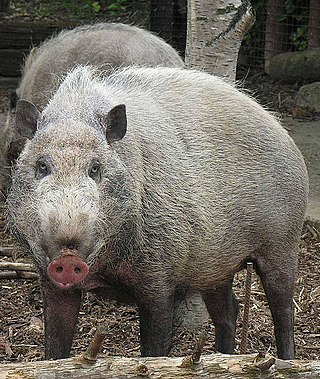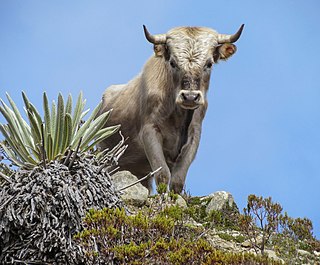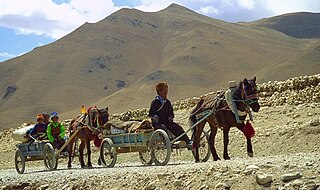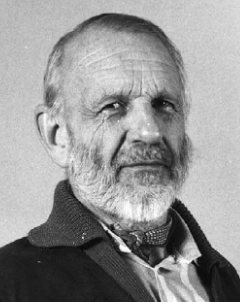Related Research Articles

Poultry are domesticated birds kept by humans for the purpose of harvesting useful animal products such as meat, eggs or feathers. The practice of raising poultry is known as poultry farming. These birds are most typically members of the superorder Galloanserae (fowl), especially the order Galliformes. The term also includes waterfowls of the family Anatidae but does not include wild birds hunted for food known as game or quarry.

Sus is the genus of wild and domestic pigs, within the even-toed ungulate family Suidae. Sus include domestic pigs and their ancestor, the common Eurasian wild boar, along with other species. Sus species, like all suids, are native to the Eurasian and African continents, ranging from Europe to the Pacific islands. Suids other than the pig are the babirusa of Indonesia, the pygmy hog of South Asia, the warthogs of Africa, and other pig genera from Africa. The suids are a sister clade to peccaries.

The chicken is a large and round short-winged bird, domesticated from the red junglefowl of Southeast Asia around 8,000 years ago. Most chickens are raised for food, providing meat and eggs; others are kept as pets or for cockfighting.

Domestication is a multi-generational mutualistic relationship between humans and other organisms, in which humans took over control and care to obtain a steady supply of resources including food. The process was gradual and geographically diffuse, based on trial and error.

Animal husbandry is the branch of agriculture concerned with animals that are raised for meat, fibre, milk, or other products. It includes day-to-day care, management, production, nutrition, selective breeding, and the raising of livestock. Husbandry has a long history, starting with the Neolithic Revolution when animals were first domesticated, from around 13,000 BC onwards, predating farming of the first crops. By the time of early civilisations such as ancient Egypt, cattle, sheep, goats, and pigs were being raised on farms.

A feral animal or plant is one that lives in the wild but is descended from domesticated individuals. As with an introduced species, the introduction of feral animals or plants to non-native regions may disrupt ecosystems and has, in some cases, contributed to extinction of indigenous species. The removal of feral species is a major focus of island restoration.

Breeding back is a form of artificial selection by the deliberate selective breeding of domestic animals, in an attempt to achieve an animal breed with a phenotype that resembles a wild type ancestor, usually one that has gone extinct. Breeding back is not to be confused with dedomestication.

The red junglefowl is a tropical bird in the family Phasianidae. It ranges across much of Southeast Asia and parts of South Asia. It was formerly known as the bankiva or bankiva fowl. It is the species that gave rise to the chicken ; the grey junglefowl, Sri Lankan junglefowl and green junglefowl have also contributed genetic material to the gene pool of the chicken.

Equine coat color genetics determine a horse's coat color. Many colors are possible, but all variations are produced by changes in only a few genes. Bay is the most common color of horse, followed by black and chestnut. A change at the agouti locus is capable of turning bay to black, while a mutation at the extension locus can turn bay or black to chestnut.

The domestication of vertebrates is the mutual relationship between vertebrate animals including birds and mammals, and the humans who have influence on their care and reproduction.

The pig, also called swine or hog, is an omnivorous, domesticated, even-toed, hoofed mammal. It is named the domestic pig when distinguishing it from other members of the genus Sus. It is considered a subspecies of Sus scrofa by some authorities, but as a distinct species by others. Pigs were domesticated in the Neolithic, both in East Asia and in the Near East. When domesticated pigs arrived in Europe, they extensively interbred with wild boar but retained their domesticated features.

The domestication of the dog was the process which led to the domestic dog. This included the dog's genetic divergence from the wolf, its domestication, and the emergence of the first dogs. Genetic studies suggest that all ancient and modern dogs share a common ancestry and descended from an ancient, now-extinct wolf population – or closely related wolf populations – which was distinct from the modern wolf lineage. The dog's similarity to the grey wolf is the result of substantial dog-into-wolf gene flow, with the modern grey wolf being the dog's nearest living relative. An extinct Late Pleistocene wolf may have been the ancestor of the dog.

Kerstin Lindblad-Toh is a scientist in comparative genomics, specializing in mammalian genetics. She is the Scientific Director of vertebrate genomics at the Broad Institute and a professor in comparative genomics at Uppsala University. In 2010 she co-founded Science for Life Laboratory (SciLifeLab) together with Mathias Uhlén and acted as Co-Director until 2015. As the leader of the Broad Institute's Mammalian Genome Initiative she has led the effort to sequence and analyze the genomes of various mammals, including mouse, dog, chimpanzee, horse, rabbit and opossum. She has researched extensively on the genetics of dogs, identifying genes and genetic variants important in disease susceptibility, morphology and behavior.

The horse genome was first sequenced in 2006. The Horse Genome Project mapped 2.7 billion DNA base pairs, and released the full map in 2009. The horse genome is larger than the dog genome, but smaller than the human genome or the bovine genome. It encompasses 31 pairs of autosomes and one sex chromosome pair.

The Paleolithic dog was a Late Pleistocene canine. They were directly associated with human hunting camps in Europe over 30,000 years ago and it is proposed that these were domesticated. They are further proposed to be either a proto-dog and the ancestor of the domestic dog or an extinct, morphologically and genetically divergent wolf population.
Jorge Dubcovsky is a plant geneticist and biologist at the University of California, Davis. He is an investigator with the Howard Hughes Medical Institute. Dubcovsky's research focuses on wheat genomics. In 2013, he was elected to the National Academy of Sciences. In 2014, Dubcovsky won the Wolf Prize in Agriculture alongside Leif Andersson.

Human uses of mammals include both practical uses, such as for food, sport, and transport, and symbolic uses, such as in art and mythology. Mammals have played a crucial role in creating and sustaining human culture. Domestication of mammals was instrumental in the Neolithic development of agriculture and of civilisation, causing farming to replace hunting and gathering around the world, and cities to replace scattered communities.

Professor David Grainger Marcus Wood-Gush FRSE was a South African-born animal geneticist and ethologist based for most of his professional life in Edinburgh. He was an expert on animal behaviour and academic author in this field. He was one of the first to study the impacts of factory farming. He advocated the study of animal behaviour to gauge what implied "humane treatment" for different species, and tried to balance these factors against economic viability for the farmer. He looked at the impact of stress upon animals and held that animals should be treated as individuals not as a "commodity". In these studies he concluded that food supply was the essential factor in controlling animal behaviour.
Siv Gun Elisabeth Andersson is a Swedish evolutionary biologist, professor of molecular evolution at Uppsala University. She is member of both the Royal Swedish Academy of Sciences and of Engineering. She is also Head of basic research at the Knut and Alice Wallenberg Foundation and has been co-director of the Swedish national center for large-scale research Science for Life Laboratory between 2017 and 2021. Her research focuses on the evolution of bacteria, mainly on intracellular parasites.
References
- 1 2 Fernholm, Ann (2012). "Domestic pigs, horses and chickens tell us about man's heritage". Wallenberg Foundation . Retrieved 7 November 2015.
- ↑ "Wolf Prize awarded to Israeli-Canadian Nahum Sonenberg". Canadian Broadcasting Corporation . 17 January 2014. Retrieved 2 November 2015.
- 1 2 3 "Researcher profile: Leif Andersson". Uppsala University . Archived from the original on 16 November 2015. Retrieved 2 November 2015.
- ↑ "American Philosophical Society: Newly Elected - April 2017". Archived from the original on 2017-09-15.
- ↑ "Pig genome mapped in major international study". Uppsala University. 15 November 2012. Retrieved 7 November 2015.
- ↑ "Scientific breakthrough in genetic studies of animal domestication". Telecommunications Weekly. 24 March 2010. Archived from the original on 21 April 2016. Retrieved 7 November 2015.
- ↑ "The genetics of the white horse unraveled". Health & Medicine Week. 4 August 2008. Archived from the original on 18 April 2016. Retrieved 7 November 2015.